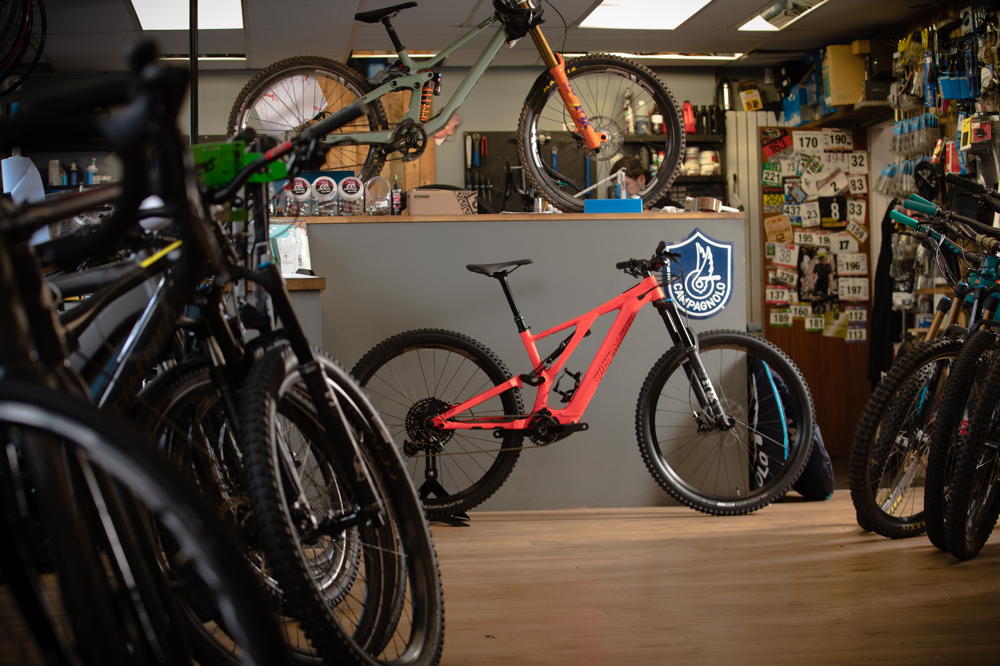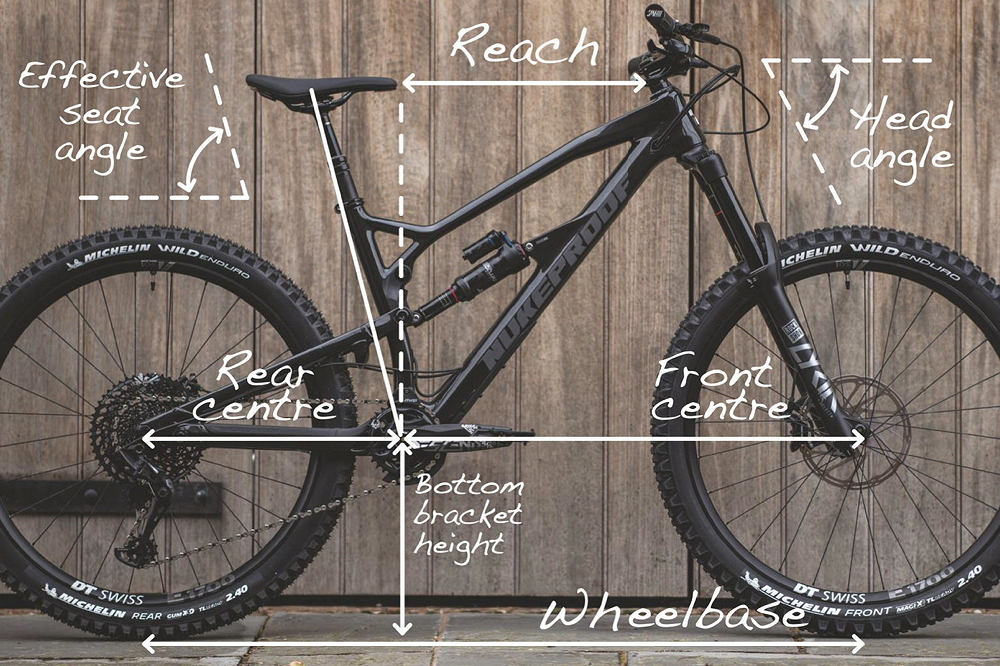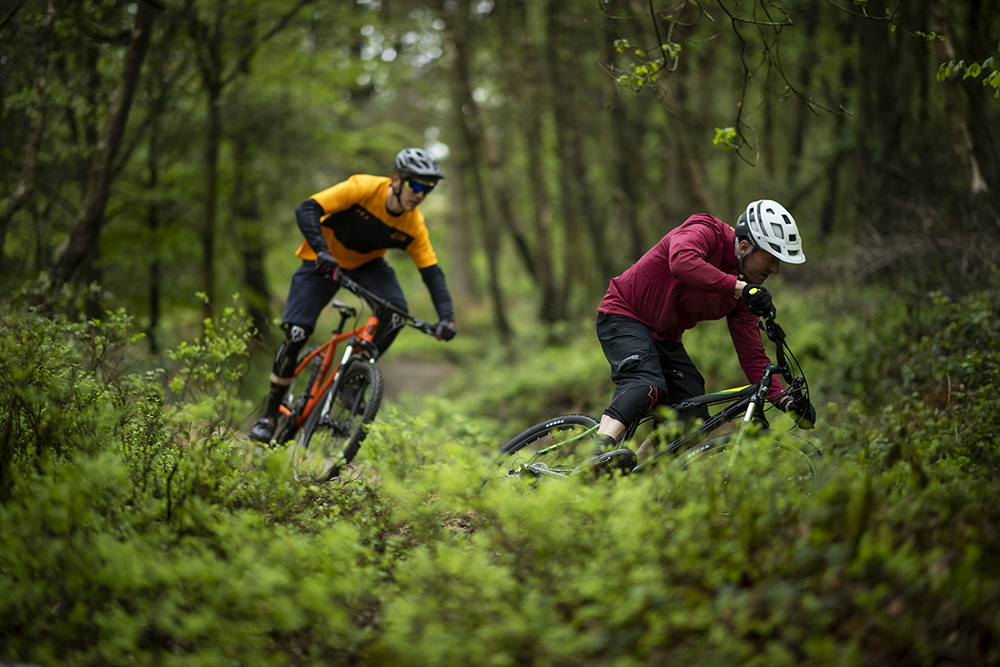Products You May Like
Picking the best beginner mountain bike needn’t be difficult or confusing. Read our expert testers’ advice and reviews to get the right MTB if you’re just starting out.
Our expert panel of reviewers and testers reveal how to choose the best beginner mountain bike. From budget advice through to must-have features and specific bike model recommendations, this guide will really help you draw up a shortlist of trail-worthy best mountain bike options for those just starting out off-road cycling.
‘View Deal’ links
You will notice that beneath each best beginner mountain bike summary is a ‘View Deal’ link. If you click on one of these links then mbr may receive a small amount of money from the retailer should you go to purchase the product from them. Don’t worry, this does not affect the amount you pay!
Best beginner mountain bike recommendations

Voodoo’s Braag is a cracking entry level mountain bike
Quality alloy frame with modern geometry that makes a great platform for future upgrades
Wheel size: 29in | Frame sizes: S, M, L, XL | Weight: 14.6kg | Suspension travel: 120mm front | Rating: N/A
Pros: Amazing price, great geometry and range of sizes, spot-on cockpit and component choices, and an active fork. Cons: The fork tops out with a clunk.
Using the same frame as the multi award-winning Voodoo Bizango (featured below) the Braag saves money in a few areas to bring the price point under £600. So you get the same confident, fun handling and excellent spread of sizes, along with a wide-range yet simple 9-speed drivetrain and a plush coil-sprung suspension fork. The only fly in the ointment is that the fork can get a bit clunky, but overall this is a killer bike for the money and one you can upgrade as your skills progress.
Read our full review of the Voodoo Braag

2022 Voodoo Bizango looks the part
The bike that rewrote the definition of entry-level hardtail performance
Wheel size: 29in | Frame sizes: S, M, L, XL | Weight: 13.1kg | Suspension travel: 120mm front | Rating: 10/10
Pros: The price, updated geometry, light weight, lower range gears, wider handlebar and improved handling. And did we say the price? Cons: You’ll probably struggle to get hold of one.
The alloy Bizango simple has no competition. It is simply unbeatable for the money. In fact, given the choice we’d probably opt for this bike over many decent £1,000 mountain bikes (saving a couple of components upgrades for the ensuing seasons). Good brakes, good gearing, plenty of standover, decent fork. Shames many bikes at twice the price.
Read our full review of the Voodoo Bizango

Vitus Sentier VR
A proper hardcore hardtail that won’t break the bank
Wheel size: 27.5in | Frame sizes: S, M, L, XL | Weight: 12.94kg | Suspension travel: 140mm front | Rating: 10/10
Pros: Great spec, fast, massively versatile and impressively light. Cons: Needs better frame protection. Resin-only rotors make upgrading to sintered brake pads more expensive than it should be.
Vitus as a brand has quickly established itself as the smart choice for anyone looking for affordable mountain bikes that shred hard and don’t cut corners. The Sentier is classic Vitus: light, versatile and fast with a spec choice that clearly shows a company run by genuine mountain bike enthusiasts. We gave the 2019 VR version our coveted Editor’s Choice award, and as the frame hasn’t really changed, we’re confident that it’s just as good now as it ever was. Vitus also makes a 29in wheel version that would be better for taller riders and covering longer distances.
Read our full review of the Vitus Sentier 27 VR
Polygon Siskiu T7
The legendary Calibre Bossnut by a different name
Wheel size: 27.5in or 29in | Frame sizes: S, M, L | Weight: 15.6kg | Suspension travel: 150mm f/140mm r 27.5in, 140mm f/135mm r 29in
Pros: High performance at High St prices. Good geometry and a solid specification with a dropper post. Cons: Unbranded tyres will need upgrading.
Calibre Bikes, sold exclusively through outdoor giant, Go Outdoors, blew the entry-level full-suspension bike market to smithereens when it launched the original Bossnut back in 2016. And it continued to be the benchmark full-suspension bike until the brand was recently discontinued. But good news: Calibre’s frames were made by Polygon, and the Indonesian manufacturer has adopted the geometry and suspension tuning that made the Bossnut head and shoulders above the competition, and applied it to the Siskiu. Also sold through Go Outdoors, the Siskiu is available with 29in or 27.5in wheels depending on the frame size, with the larger frames using 29in wheels and the smaller ones getting 27.5in hoops. At a great price tag, the Polygon Siskiu makes the perfect starter full-suspension bike for all types of trail riding.

Vitus Mythique VRX
High performance trail bike at an unbeatable price
Wheel size: 27.5in or 29in | Frame sizes: S, M, L, XL | Weight: 14.6kg | Suspension travel: 150mm f/140mm r 27.5in, 140mm f/135mm r 29in | Rating: 9/10
Pros: Cutting-edge sizing and geometry. Cons: Needs a better shock tune and a dropper post.
There are three different models in the Vitus Mythique range, with prices starting at £1,349.99 and topping out at £1,799.99. All three models use the same alloy frame with four-bar linkage suspension, but wear different components depending on the price point. Like Polygon, Vitus uses both 27.5in and 29in wheels for the Mythique range, but in this case all four frame sizes are available with either wheel, so you don’t have to compromise on your ultimate combo. Cheaper bikes get X-Fusion suspension, which can be a little harsh in our experience, so if you can stretch to the top VRX model, with its Marzocchi fork and RockShox shock, you’ll find yourself going faster with greater control. All-in, the Mythique is a mighty fine way to spread your full-suspension wings.
Read the full review of the Vitus Mythique 27 VR

Destiny waiting at the till
How much should you spend on the best beginner mountain bike?
We’re not going to come out with a specific price point that you should be aiming for if you’re just starting out in mountain biking. People are different. Some people will want to spend as little as possible. Other folks will want to less money-mindful and will just want to dive straight in and splash the cash. Then there’ll be the mid-range folk who don’t want to skimp but also don’t want to be wasting their hard-earned on OTT MTBs.
All we would say is that you should be spending at least £400. And be aware that the law of diminishing returns with mountain bike price tags kicks in at around £2500 mark. In other words, bikes do get better and/or lighter if you spend more than £2.5k but the leaps in progress get smaller and smaller the more money you throw it at. You really are get very little more for your money when you enter the realm of bikes costing more than £3k.

Hardtails are fun no matter your experience level
Hardtail or full-suspension
It’s often not fashionable to talk about weight and efficiency in mountain bike circles. But they both matter. A lot. Hefty and soggy bikes definitely have their place for experienced riders riding certain types of terrain. But far too many people never get to grips with mountain biking purely because they start out on heavy or inefficient bikes.
Riding mountain bikes uphill off-road is flipping hard work, regardless of what bike you’re on. Don’t make it any worse than it has to be by buying a low-end full-suspension bike. Sure you can get impressive full suspension bikes for a little over £1k these days but they are still significantly heavier than similar priced hardtails.
The other aspect of full suspension bikes is that they absolutely require knowledge and – more importantly – the will to spend time setting them up properly. You can’t just buy a full suspension bike and hit the trails. They require setting up for your weight, your riding style and your terrain. And they require numerous rides to perfect the set-up.
With full-suspension you are buying into greater performance and capability certainly, but you are also committing yourself into considerable set-up sessions as well as more maintenance in general.
We still recommend that beginners go down the route of choosing the best hardtail mountain bike unless their budget is more than £1,500.

mountain bike geometry
Size and geometry
Whatever budget you’re trying to stick to, there are two overriding concerns: frame size and geometry.
Frame size and geometry are related but they are two separate entities. Frame size denotes what height of person best fits it. Geometry denotes what sort of terrain and/or riding discipline the bike is best suited to.
Do not ever buy a bike that is the wrong size because it’s in the sale or a ‘bargain’. A poorly equipped bike that’s the correct size for you will be better than a well-specced bike that is too small or too large. We go into frame size recommendations in this guide.
Standover
A quick note about standover. Standover is essentially how low slung the bike’s top tube is (AKA cross bar). The more room you have to straddle your bike’s top tube will do wonders for your confidence when off-road. Having a too high top tube makes you scared of being to get off safely should the worst happen. Basically, look for a bike frame with a very sloping top tube. Avoid bikes that have top tubes that are near-parallel to the ground.

Are you aiming for Olympic gold?
Types of mountain bike
Similarly, don’t be tempted into buying a bike that isn’t going to be best suited to the type of riding you actually will be doing on it. In other words, don’t buy a twitchy XC race bike (like the one pictured above) if you like steep, sketchy, technical trails. And don’t buy a burly long-travel enduro bike if your trails don’t have much in the way of gradient or technicality.
If in doubt go for a trail bike. What is a ‘trail bike’ you ask? It’s a typically woolly and vague description but we’d say a trail bike is any mountain bike with a suspension fork with 120mm to 150mm of travel. Geometry-wise, a trail bike should have a head angle no steeper than 66°.

Wide-ranging cassettes are a godsend
Components
After frame size and geometry, the second-level concerns are spec related. Namely, brakes and gears. You need hydraulic disc brakes and you need gears that aren’t too steep.
Hydraulic disc brakes are relatively easily identified but appropriate gearing can be hard to fathom from just looking at bike spec sheets. The best thing to look at is the cassette ie. the bunch of gear sprockets on the back wheel. The bigger the cassette is, the better. We wouldn’t like to head off-road with a cassette that didn’t have a largest sprocket of at least 42T. Mountain biking is difficult enough as it is without having to heave and strain tall gearing up climbs. To access truly large cassettes you probably need to be looking at bikes with 10-speed drivetrains or higher (11 or 12 speed).

Actual wheel sizes
Wheel size
First of all, wheel size does not matter as much as the hype would lead you to believe. It is certainly way less important than frame size and geometry. Wheel size is arguably less important than brakes and gearing in fact.
As MBR testers, we hop between 27.5in and 29in wheel bikes all the time and it’s fine. Arguably, 29ers suit more people best but, again, we’d rather ride a good 27.5in bike than a poor 29er.
Having said that, if you’re over 6ft tall, you might find 27.5in wheel bikes a bit too dinky (you feel a bit too much ‘on top’ of the bike rather than ‘in’ it). And if you’re nearer the 5ft mark, you’ll feel lost in between 29in wheels and you would have a better time on a 27.5 bike.

Carbon is nice but hardly essential
Is carbon worth it?
No.
There’s nothing wrong with carbon but it certainly is not worth the price premium.
Carbon frames are a bit lighter than aluminium (or steel) frames but not by as much as you might think. How much weight do you save by spending, say, an extra £1000 to get the carbon frame version of a bike model? About 700g. Now then, 700g may be significant on a high end road bike (700g could be approx 10% of overall bike weight) but on MTB trail bikes that weigh 14kg+ it is much more marginal.

Online temptations
Mail order or bike shop?
If you truly are a beginner to mountain biking, then we’re going to nail our colours to the mast here and emphasize the added value of getting your first proper mountain bike from a real bricks-and-mortar bike shop. Bike shops give you knowledge and experience. Two vital things when starting out mountain biking and both worth their weight in gold. Not to mention the fact that in most instances you can sit astride a real bike and potentially even actually go for a test ride on a demo bike.
By all means enjoy the (considerable) money saving of a direct-sales mail-order bike when it comes to future bike purchases but you really need to be visiting a real-world bike shop for buying your first MTB.
Ask around for recommendations on which bike shops to visit. Ask any MTBing friends or family you have. Ask on social media for where the decent bike shops are. Good bike shops won’t let you walk out with the wrong bike. Good bike shops don’t want to fleece you. Good bike shops want you to come back to them again and again. Good bike shops want to have a relationship with their customers.


